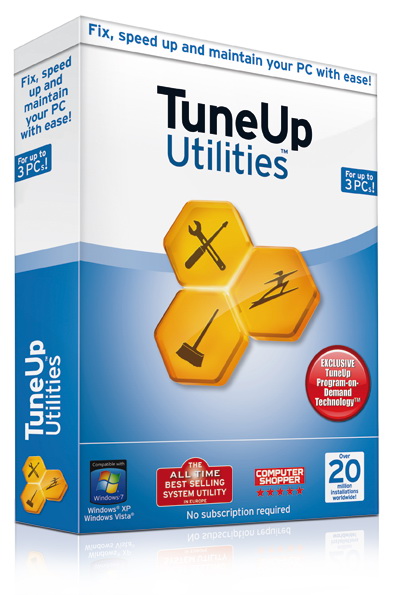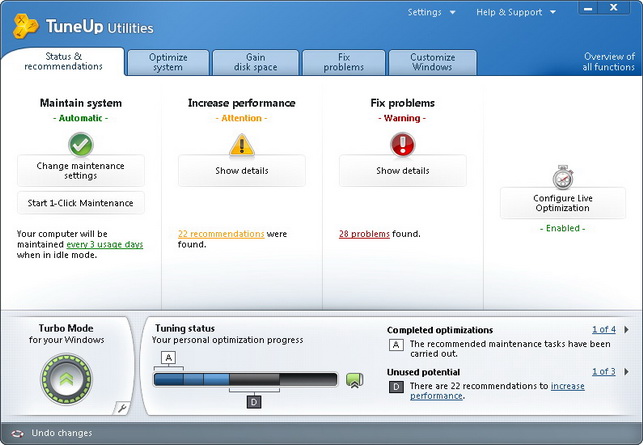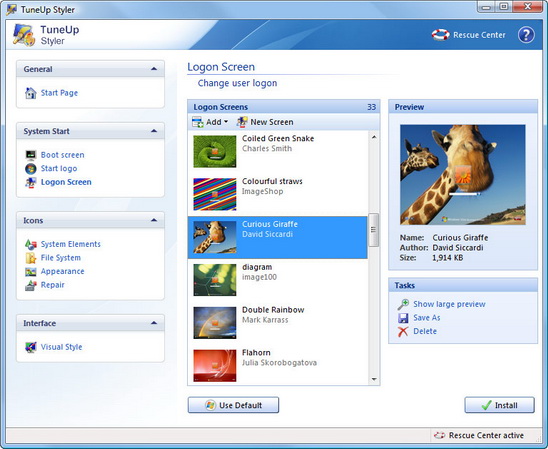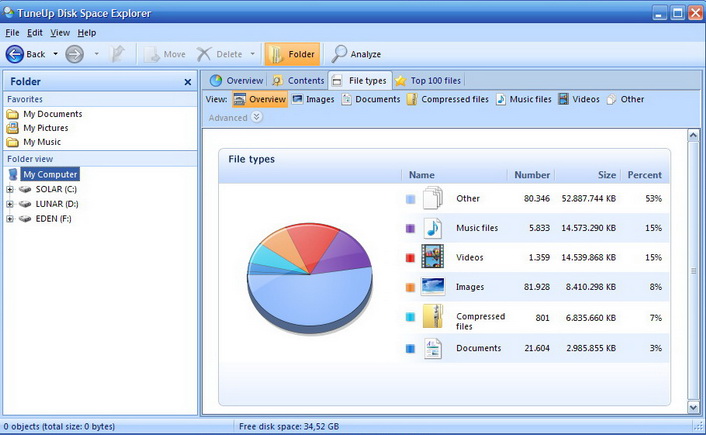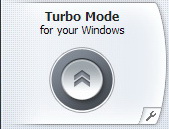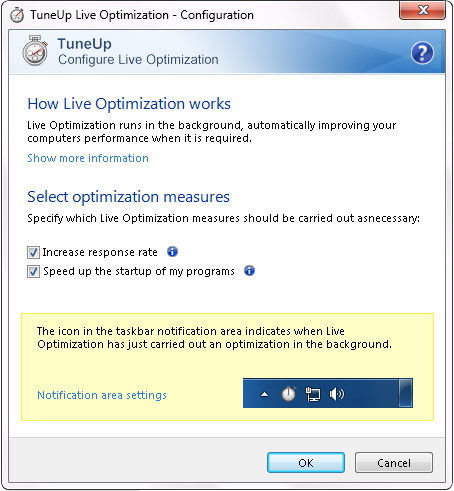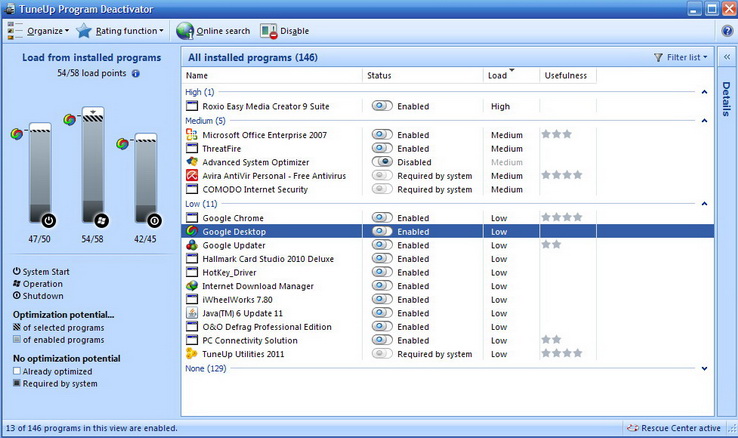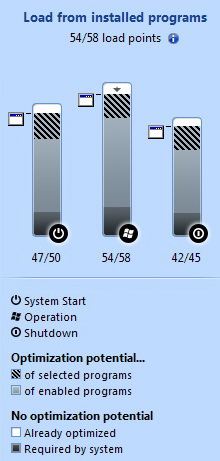TuneUp
Utilities 2011 Review
Summary: With big improvement over several key features from last version and an introduction of the innovative TuneUp Program Deactivator, TuneUp Utilities 2011 has raised the bar on the competition. By saying that, this is simply still the best Windows optimization software out there. From the sleek design, effective and dynamic system condition analysis, abundance tools and utilities that each is presented with care in detail, to “one-click” optimization mechanism that also open possibilities for advance user to explore, you can see that TuneUp has produced a perfect optimization software for everyone. What We Like: Everything. The presentation, the interface, the number of tools and utilities, method of optimization, and even the price that is very reasonable for software this good. What We don’t Like: Almost nothing except that we expected TuneUp provided a tuned-down version inside the package to be used for slower systems like netbook or other Intel Atom powered systems. But this might seem quite unfair as other products require us to pay more by buying the separated netbook-version.
Last
week, TuneUp sent me their copy of the new TuneUp Utilities 2011 just
before the retail version was released. As a regular user of the program, I was
delighted that I had the opportunity to be among the first people who can test
the new version. Honestly, there are not many PC optimization programs that can
truly offer you a true automatic optimization features. What I have seen this
far is a bunch of programs that throw us a compilation of tools and utilities
in one package but nothing else. And personally for me, there are only two
Windows optimization programs that I constantly keep my eyes on: Iolo System
Mechanic and of course TuneUp Utilities. Is This just Another Windows Optimization
Software?
With these two rating systems, even a beginner could decide which program to disable. The ratings itself are maintained and updated independently both offline and online. Furthermore, if TuneUp finds a program unnecessary, it will automatically give the recommendation on the main menu below the “Increase Performance” alert column. Recommendation like this that impact overall system performance will be updated automatically and dynamically every time. This appears not only inside TuneUp menu but also pops out automatically from the notification area of your desktop. So you see that the three concepts are applied nicely here.
Beginner and Advance Users are Welcome
The
three aspects are also apparent as soon as you load TuneUp Utilities and see
the main menu for the first time. You will be greeted with a screen that could
be described as your system condition summary. There are reports about
“Performance” and “Problems” which are updated automatically and dynamically
both when the program runs and active in the background. So you will see
different result in different time and condition depending on what you have
done with your system. If TuneUp find any problems it will show you its
recommendation and conduct an immediate action as soon as you approve it. There
is also Tuning status that reports the progress of the optimization steps that
have been carried out. This is important to remind you which recommendation
that hasn’t been taken. So overall, the main menu provides an easy way to
optimize your system and bring any potential out of it even when you are only
starting the program for the first time. This way, you will not wondering
around thinking what you should do next with the program.
From
all the tools inside TuneUp Utilities 2011, maybe the most unrelated tool to
the optimization process yet the most surprisingly great is Customize Windows
category. Here besides tweaking Windows settings you can also change your boot
screen, Windows visual style, or the whole Windows theme as well and pick from
your own collection or from dozens of TuneUp own themes library online. Usually
to do this you need a stand-alone software like StyleXP or ThemeXP. 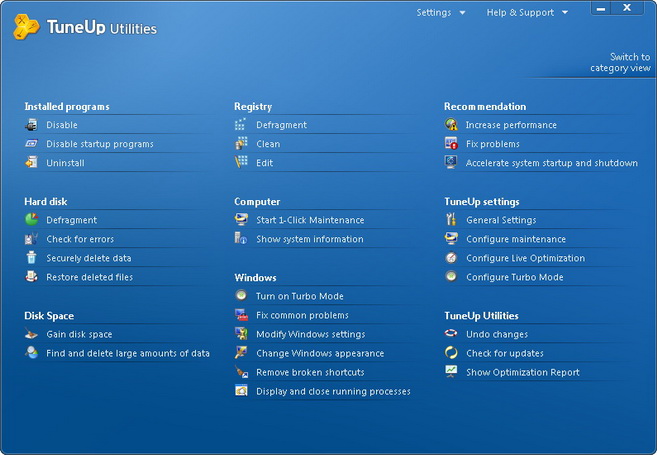
If you want a straight access to all of TuneUp tools, just click “Overview of all functions” button at the upper right corner of the menu. You will find 30 individual tools are awaiting your order. So overall, although TuneUp has laid everything important at the main menu to ease up your optimization work, accessing each individual tool to find more room either for optimization, gain more disk space, or beautify Windows is very easy.
Is There More Special Features?
There
are two other main features that TuneUp has brought once again after it being
first introduced in the last 2010 version: Turbo Mode and Live Optimization.
Turbo Mode is a feature that provides us an immediate performance boost by
slowing down or disabling entirely the programs or Windows functions that runs
in the background and not critically needed at the time. This is very useful if
you load a heavy-duty program like high-system-required games, video editor,
picture editor, or play high definition video. And according to TuneUp, this
version’s Turbo Mode was 10 times more powerful because it can shut down over
70 Windows background process from previously only 7.
Live Optimization, the second big feature that is also brought from the last version is created to help you increase computer’s response rate and program’s start up. It works by learning your activity when using your computer and set a priority on which program needs more resource when loading and which program should have lower priority because it takes too much resource. In my experience, this feature was helpful when I used multiple programs at once while Turbo Mode is handy when I used one single task like playing Crisis or watching 1080p Avatar.
One innovative feature that is introduced in TuneUp Utilities 2011 is TuneUp Program Deactivator. I think it is an answer for our frustration whether to uninstall or leave alone a program that we rarely use. Some programs, even though they are not used, take more or less system performance by loading their services, startup entries, background processes, or scheduled tasks. This is a dilemma. Fortunately with Program Deactivator, you can choose to disable the programs with all of its consumption on the system resource just like it never existed. And unlike uninstalling an entire program, enabling a program only needs a click and a second away. This tool even gives you a report of programs with their own load weight in the system resource.
To give you the idea on how this feature works, please take a look at the picture below. I have a Roxio Easy Media Creator that I used for editing video and creating some digital picture creation easily. Even though I rarely use it recently, I still want to keep it in case I have new photos or videos for showcase in special days like New Year. But when I see the report of TuneUp Program Deactivator, sadly this program takes about 20 percent of the total system resource being used. And thus, I have found one of the reasons that make my computer not in full shape. Fortunately, with TuneUp 2011 I don’t need to uninstall this useful program. I just slide the status button to ‘Disabled’ and all of its components that take my system resource will be disabled just like what I want when a program is not used. In practice, my Windows startup and shutdown time has been reduced around that percentage. And this is huge. It means around 15 and 3 seconds respectively. Overall system performance when I doing activities like loading programs and copying or moving data also increases. And the sweet thing about this feature is that, if one day I need Roxio EMC again, I just slide the button to ‘Enabled’ and it is ready to use. Overall, it is a very creative and helpful innovation for actual, real life Windows optimization.
The Verdict Answering
the tag line of this title, yes TuneUp has convincingly kept the crown of the
best Windows optimization software with this new version. In fact, with the
improvement of some elements from previous version and an additional new
innovative feature that is very effective in real-life optimization, TuneUp has
raised the bar for others to match. Overall, this is a must-have program for
Windows users who want to keep their system in top shape without ever needed to
reinstall their Windows and all their programs all over again. |
|
